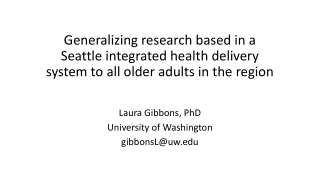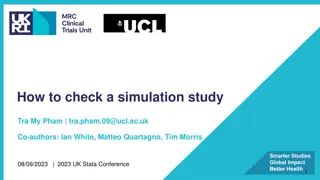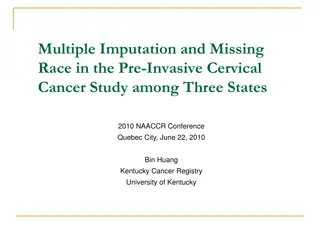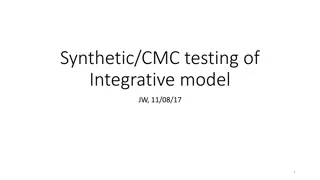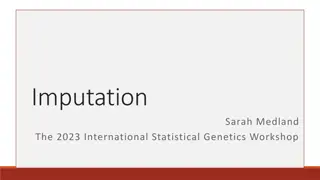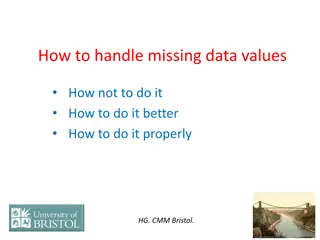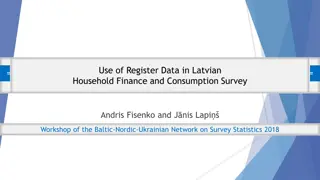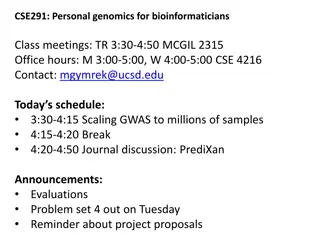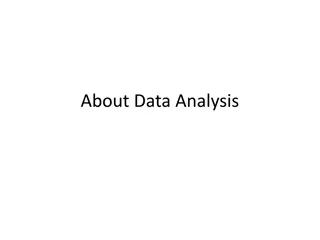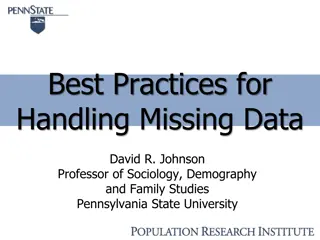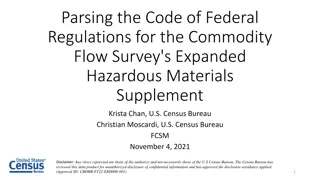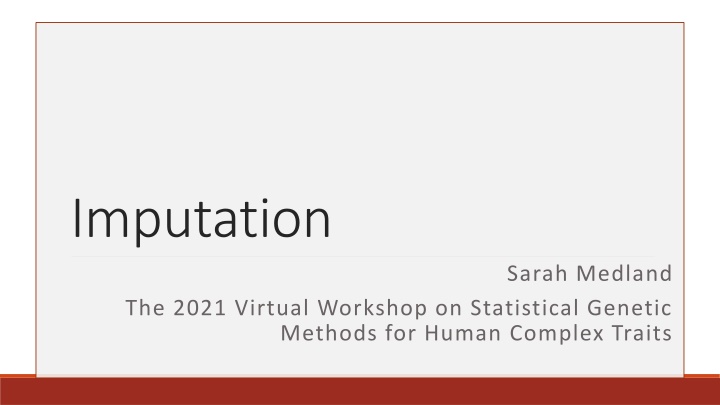
Imputation Methods for Genetic Analysis
Discover the importance of imputation in genetic studies, including its applications in meta-analysis, fine mapping, and data combination. Learn about the process of imputation, its benefits, and how it aids in correcting genotyping errors. Explore the steps involved in imputation and the significance of referencing public data for enhanced genetic analysis.
Download Presentation

Please find below an Image/Link to download the presentation.
The content on the website is provided AS IS for your information and personal use only. It may not be sold, licensed, or shared on other websites without obtaining consent from the author. If you encounter any issues during the download, it is possible that the publisher has removed the file from their server.
You are allowed to download the files provided on this website for personal or commercial use, subject to the condition that they are used lawfully. All files are the property of their respective owners.
The content on the website is provided AS IS for your information and personal use only. It may not be sold, licensed, or shared on other websites without obtaining consent from the author.
E N D
Presentation Transcript
Imputation Sarah Medland The 2021 Virtual Workshop on Statistical Genetic Methods for Human Complex Traits
3 main reasons for imputation Meta-analysis Fine Mapping Combining data from different chips Other less common uses sporadic missing data imputation correction of genotyping errors imputation of non-SNP variation
Fine Mapping GWAS using only genotyped SNPs
Fine Mapping Genotyped only Post-Imputation
1. Starting Data Genotyped sample . . C . . G . C . Reference haplotypes A G A T C T C C T A G C T C T C A T A G A T C G C C T A G A T C T A C T
2. Identify shared regions of chromosome Genotyped sample . . C . . G . C . Reference haplotypes A G A T C T C C T A G C T C T C A T A G A T C G C C T A G A T C T A C T
3. Fill in missing genotypes Genotyped sample A G C T C G C C T Reference haplotypes A G A T C T C C T A G C T C T C A T A G A T C G C C T A G A T C T A C T
Step 1 QC & references Current Publically Available References HapMapII (no phased X data officially released) 1KGP phase 3 version v5 References only available via custom imputation servers HRC - 64,976 haplotypes 39,235,157 SNPs CAPPA African American/Carabbean Multi-ethnic HLA Genome Asia Pilot - GAsP TopMed - 97,256 haplotypes 308,107,085 SNPs (b38)
Step 2 Phase your data In this context it is really Haplotype Estimation We take genotype data and try to reconstruct the haplotypes Can use reference data to improve this estimation
Phasing in Eagle2 or Shapeit2 Hidden Markov Models are used to reconstruct haplotypes in the genotyped data These are used to provide scaffolds for the imputation
Step 3: Impute Minimac4 Impute5 Positional Burrows Wheeler Transform (PBWT) Beagle never use plink for imputation!
Minimac4 https://github.com/statgen/Minimac4 Building on the work from Gon alo Abecasis, Christian Fuchsberger and colleagues Analysis options SAIGE BoltLMM plink2
Impute5 https://jmarchini.org/software/#impute-5 Built by Jonathan Marchini and colleges Incorporating Positional Burrows Wheeler Transform (PBWT) Downstream analysis options BGENIE SNPtest Quicktest
Options for imputation DIY Use a cookbook! http://genome.sph.umich.edu/wiki/Minimac3_Imputation_Cookbook OR http://genome.sph.umich.edu/wiki/IMPUTE2:_1000_Genomes_Imputation_ Cookbook UMich Imputation Server https://imputationserver.sph.umich.edu/ Sanger Imputation Server https://imputation.sanger.ac.uk/ TOPMed Imputation Server https://imputation.biodatacatalyst.nhlbi.nih.gov/
On the Michigan Imputation Server Site - Great practical workshop sessions from ASHG 2020 https://imputations erver.readthedocs.io /en/latest/workshop s/ASHG2020/
Preparing your data i. Exclude snps with excessive missingness (>5%), low MAF (<1%), HWE violations (~P<10-6), Mendelian errors Drop strand ambiguous (palindromic) SNPs ie A/T or C/G snps iii. Update build and alignment (b37 vs b38) iv. Output your data in the expected format for the phasing program you will use Check the naming convention for the program and reference you want to use rs278405739 OR 22:395704 ii.
Output 3 main genotype output formats Hard call or best guess Dosage data (most common 1 number per SNP, 1-2) Probs format (probability of AA AB and BB genotypes for each SNP)
Output Info files
The r2 metrics differ between imputation programs
In general fairly close correlation rsq/ ProperInfo/ allelic Rsq 1 = no uncertainty 0 = complete uncertainty .8 on 1000 individuals = amount of data at the SNP is equivalent to a set of perfectly observed genotype data in a sample size of 800 individuals
Post imputation QC After imputation you need to check that it worked and the data look ok Things to check Plot r2 across each chromosome look to see where it drops off Plot MAF-reference MAF
Good imputation Bad imputation
Post imputation QC Next run GWAS for a trait ideally continuous, calculate lambda and plot: QQ Manhattan SE vs N P vs Z Run the same trait on the observed genotypes plot imputed vs observed
Last points If you are running analyses for a consortium they will probably ask you to analyse all variants regardless of whether they pass QC or not (If you are setting up a meta-analysis consider allowing cohorts to ignore variants with MAF <.5% and low r2 it will save you a lot of time)

